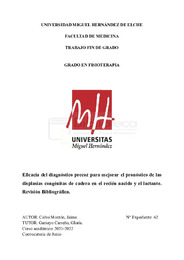Por favor, use este identificador para citar o enlazar este ítem:
https://hdl.handle.net/11000/28115Registro completo de metadatos
| Campo DC | Valor | Lengua/Idioma |
|---|---|---|
| dc.contributor.advisor | Gamayo Carreño, Gloria | - |
| dc.contributor.author | Calvo Montón, Jaime | - |
| dc.contributor.other | Departamentos de la UMH::Patología y Cirugía | es_ES |
| dc.date.accessioned | 2022-10-28T10:44:52Z | - |
| dc.date.available | 2022-10-28T10:44:52Z | - |
| dc.date.created | 2022-06-20 | - |
| dc.identifier.uri | https://hdl.handle.net/11000/28115 | - |
| dc.description.abstract | INTRODUCCIÓN: La displasia congénita de la cadera (DCC) recoge un amplio espectro de alteraciones del acetábulo y del fémur proximal. La incidencia de la enfermedad es de 5 por cada 1000 nacidos vivos en México. No detectar a tiempo una DCC en el recién nacido o el lactante puede condicionar negativamente al desarrollo psicomotor del mismo. Un diagnóstico precoz (DP) puede comenzar en el recién nacido, con el examen visual y la exploración física, seguido de las evaluaciones ecográficas y radiológicas. Se plantea el tratamiento conservador como una medida preventiva en el desarrollo de la patología previo a la osificación del núcleo. Por todo esto, es necesario valorar si la prevención (diagnóstico y tratamiento precoz) es el arma más eficaz en el manejo de la DCC. OBJETIVOS: Conocer si un DP en una DCC del recién nacido y del lactante previene el desarrollo de la patología y/o mejora el pronóstico de la misma. MATERIALES Y MÉTODOS: En esta revisión bibliográfica realizada en abril de 2022, se incluyeron 8 artículos recuperados en 6 bases de datos: PubMed, Scopus, PEDro, Cochrane Library, ENFISPO y Science Direct. RESULTADOS: La ecografía fue la herramienta diagnóstica aplicada con más frecuencia. Algunos estudios identificaron mejoras significativas y clínicamente relevantes en la evolución de la DCC de los bebés después del diagnóstico precoz (< 6 meses aproximadamente) y el tratamiento temprano. No obstante, el DP y la intervención conservadora temprana no dieron los resultados esperados en aquellas caderas con DCC severas o no reductibles (tipo III o IV en el método de Graf). CONCLUSIONES: La prevención sí parece ser una herramienta eficaz en el manejo de la DCC. Asimismo, el fisioterapeuta puede favorecer el correcto desarrollo madurativo del bebé, y es necesario que se incluya esta figura en los programas de cribado y las evaluaciones de seguimiento de los bebés con DCC. | es_ES |
| dc.description.abstract | INTRODUCTION: Congenital hip dysplasia (CHD) includes a wide spectrum of alterations of the acetabulum and proximal femur. The incidence of the disease is 5 per 1000 live births in Mexico. Failure to detect CHD early in the newborn or infant can negatively affect the psychomotor development of the child. Early diagnosis (ED) begins in the newborn, with visual and physical examination, followed by ultrasound and radiological evaluations. Conservative treatment is proposed as a preventive measure in the development of the pathology prior to ossification of the nucleus. As a result, it is necessary to assess whether prevention is the most effective weapon in the process of diagnosing and treating CHD. PURPOSE: To research if ED in newborn and infants with CHD prevents the development of the pathology and/or improves its prognosis. METHODS: In this review conducted in April 2022, 8 articles from 6 databases were retrieved: PubMed, Scopus, PEDro, Cochrane Library, ENFISPO and Science Direct. RESULTS: Ultrasonography was the most frequently applied diagnostic tool. Some studies identified significant and clinically relevant improvements in the evolution of CHD in infants after early diagnosis (< 6 months approximately) and early treatment. However, ED and early conservative intervention did not give the expected results in infants with severe or non-reducible CHD (type III or IV in Graf's method). CONCLUSIONS: Prevention seems to be the most effective weapon in the process of diagnosing and treating CHD. In addition, physiotherapy can assist the correct development of newborn and infants. It is necessary to include physical therapists in screening programmes and follow-up examinations of babys diagnosed with CHD. | es_ES |
| dc.format | application/pdf | es_ES |
| dc.format.extent | 32 | es_ES |
| dc.language.iso | spa | es_ES |
| dc.publisher | Universidad Miguel Hernández de Elche | es_ES |
| dc.rights | info:eu-repo/semantics/openAccess | es_ES |
| dc.rights.uri | http://creativecommons.org/licenses/by-nc-nd/4.0/ | * |
| dc.subject | Diagnóstico precoz | es_ES |
| dc.subject | Displasia congénita de cadera | es_ES |
| dc.subject | Lactante | es_ES |
| dc.subject.other | CDU::6 - Ciencias aplicadas | es_ES |
| dc.title | Eficacia del diagnóstico precoz para mejorar el pronóstico de las displasias congénitas de cadera en el recién nacido y el lactante. Revisión Bibliográfica. | es_ES |
| dc.type | info:eu-repo/semantics/bachelorThesis | es_ES |

Ver/Abrir:
Eficacia del diagnóstico precoz para mejorar el pronóstico de las displasias congénitas de cadera en el recién nacido y el lactante. Revisión bibliográfica.pdf
640,1 kB
Adobe PDF
Compartir:
 La licencia se describe como: Atribución-NonComercial-NoDerivada 4.0 Internacional.
La licencia se describe como: Atribución-NonComercial-NoDerivada 4.0 Internacional.
.png)